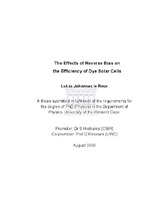The effects of reverse bias on the efficiency of dye solar cells
Abstract
Dye-sensitised solar cells (DSC) have attracted much attention during the last few years due to their high efficiencies and their potentially low production costs. The technology is based on a thin layer of nano sized, high band gap (3.2 eV) TiO2 film. A Ru containing dye (from hereon called the Ru dye) is chemisorbed onto the TiO2 film. This combination acts as the working electrode. The counter electrode consists of a platinum layer which is the catalyst for the regeneration of the Iodine/Iodide electrolyte. The work that is presented here is focused on the results that were obtained during studies of the performance of the DSC under certain reverse bias conditions. When one cell in the series connection in a module is shaded, the current will pass this cell in reverse bias. In such a case the shaded cell will be subjected to a voltage in the reverse direction coming from the other lit cells in the module. This reverse voltage could permanently modify or damage the cell if it is not properly protected. Although the work is focussed on the chemical stability of the dye, various techniques were employed to determine the physical changes in the cell. It was found that a cell that was subjected to a reverse bias of 2 V for 500 min showed a 58% recovery and a cell that was subjected to 4.5 V reverse bias was irreversibly damaged. The UV-vis spectra showed a blue shift (higher energy), the Raman showed no peak at 1713 cm-1 (which indicates the absence of free carboxylate groups) and the FT-IR showed the disappearance of the NC-S absorption band at 2100 cm-1. The combined conclusion is that the - NCS ligand has been depleted and replaced with I3- ions. When measuring the impedance, the Nyquist plots showed an increase in the charge transfer resistance at the counter electrode when subjected to a reverse bias potential of 2 V. This is confirmed by the Bode plots. This indicates a partial oxidation of the Pt catalyst on the counter electrode. It can therefore be stated with confidence that the changes in the cell after being subjected to a reverse bias potential of 2 V for 500 min are changes on the -NCS bonds on the Ru dye as well as the Pt in the counter electrode.

